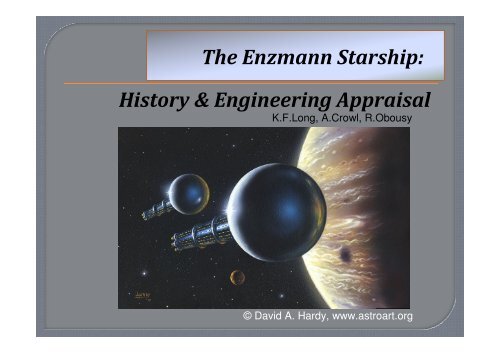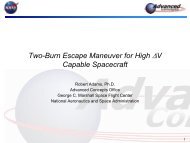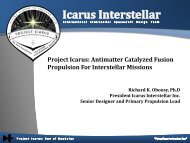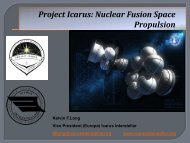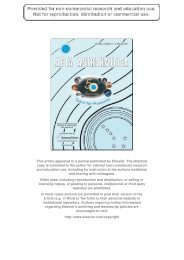The Enzmann Starship: History & Engineering ... - Icarus Interstellar
The Enzmann Starship: History & Engineering ... - Icarus Interstellar
The Enzmann Starship: History & Engineering ... - Icarus Interstellar
Create successful ePaper yourself
Turn your PDF publications into a flip-book with our unique Google optimized e-Paper software.
<strong>The</strong> <strong>Enzmann</strong> <strong>Starship</strong>:<strong>History</strong> & <strong>Engineering</strong> AppraisalK.F.Long, A.Crowl, R.Obousy© David A. Hardy, www.astroart.org
What is the <strong>Enzmann</strong> <strong>Starship</strong>?<strong>History</strong> of the Concept• Space Art• Technical Developments<strong>Engineering</strong> AppraisalBig Thinking <strong>Enzmann</strong>’sBigger Thinking <strong>Enzmann</strong>’sConclusions
Robert Duncan <strong>Enzmann</strong>• -Jay Snyder• -Michelle SnyderRick SternbachDon DavisDavid HardyGreg MatloffAuthors: A.Martin, A.Bond, G.Stine,M.Michaus, Thomas Schroeder, Ian Ridpath,Roy Gallant, Robert Bussard.
Well known about in thescience fiction community. Not well known in theinterstellar researchcommunity. We wanted to clarify itshistory, raise its profile andgive a basic engineeringassessment of its credibility.What is the <strong>Enzmann</strong> <strong>Starship</strong>?
Origins: Robert <strong>Enzmann</strong> (1964-1966) Claimed submission of report to New York Academy of Sciences in 1964.No such report exists. 1966, <strong>Enzmann</strong> submits papers relating to “Mission Planning” to the NewYork Academy of Sciences. But, no mention of <strong>Starship</strong>s. Although Robert <strong>Enzmann</strong> is the originator of the concept, as will beshown, Rick Sternbach and Don Davis must receive some credit for its‘augmented lollypop’ configuration. G.Harry Stine’s Analog article did much to publicise the concept as well. 1978 ‘messages to the stars’ book by Ian Ridpath claimed <strong>Enzmann</strong><strong>Starship</strong> invented in 1964. 1972 Science Digest article by Robert Bussard claimed <strong>Enzmann</strong> <strong>Starship</strong>invented in 1969. 1984 ‘World Ship’ article in JBIS by Anthony Martin and Alan Bondclaims <strong>Enzmann</strong> starship invented in mid 1960s. Referred to a ‘snowball’design. 3-10 vehicles, 0.01c cruise speed, 2002000 population increase.
Origins: Robert <strong>Enzmann</strong> (1946) Robert Duncan<strong>Enzmann</strong> PhD, MIT Professor Raytheon Corporation Says he thought ofconcept August 6 th1945 (day of firstWW2 Japanbombing). 1940s seems too early,we think 1960s morelikely based ondiscussions with RickSternbach.(Robert <strong>Enzmann</strong>, 1949)
S.S.Statendam, 24,000 gross tons, 196 mlength, built 1957, 881 capacity, speed16.5 knots. Later part of Regency Cruises fleet andrenamed Regent star. But company went bankrupt. Ship scrapped in India 2004. December 1972 space conference towatch launch of Apollo 17. New York to Cape Canaveral. 4 th Conference on Planetology and SpaceMission Planning “<strong>The</strong> Cruise & I”, Isaac Asimov, July1973 issue <strong>The</strong> Magazine of Fantasy &Science Fiction. ‘<strong>The</strong> Ship of Fools’
CORNUCOPIA OF SPACEBruce Hunt: Co-ChairmanDonald Banks: Co-ChairmanIsaac Asimov: What is a CornucopiaNorman Mailer: Is there a Cornucopia out there?Pandora Duncan: Planetary rover designsRobert D <strong>Enzmann</strong>: Out of the CornucopiaRichard Hoagland: <strong>The</strong> Space ShuttleBen Bova: Expanding the CornucopiaBerguet Roberts: Last Lunar Flight DreamsECOLOGICAL NICHESKrafft Ehricke: Co-Chairman Extraterrestrial IndustriesKenneth Franklin: Co-ChairmanEric Burgess: Emerging Conscience of ManRoger Caras: Earth the Teacher, Lessons learned from out 1stplanetIsaac Asimov: A heirarchy of niches from comets to EarthlikeplanetsNeil Ruzic: Development of the moon as a nicheRichard Sternbach: Experiment that failedDon Davis: Paintings: ClonesPROPULSION INTELLIGENT MACHINES AND SOCIO-GENETIC CHANGERoger Caras: Co-chairmanHarry Stine: Co-chairman <strong>The</strong> Third industrial RevolutionRobert Heinlein: Genetic fitness, Social fitness, training &technology and communicationsMarvin Minsky: Artificial intelligenceSarah Meltzoff: Universals, Cultural viability, economicspecializationJanet Jepperson: Psychological barriers to full realizationLinda Sagan: Comment: Ultimate MachinesKrafft Ehricke: Comment: Ultimate MachinesThis conference was probably thefirst (and only) public discussion by<strong>Enzmann</strong> of his <strong>Starship</strong> concept. ENERGY AND PROPULSION Donald Banks: Co-Chairman Energy Ben Bova: Co-Chairman Werner Rambauske: Observation of the Universe Brude hunt: Propulsion Robin Anderson: Plowshare: Big guns for the benefit of thepeople Fred Pohl: <strong>The</strong> shape of shadows from the future Carl Sagan: <strong>Interstellar</strong> probes and Pioneer 10 Neil Ruzic: Human acquisition of Moon and its effects on warand peaceTHE GRAND DESIGNGillet Griffin: Co-chairmanEric Burgess: of Mankind but no longer MenCassandra Boell: Space states and the howling of beastsHarry Stine: Comment: Ultimate MachineRobert D. <strong>Enzmann</strong>: Statement of grand design, & galacticfertile crescentRobert Heinlein: <strong>The</strong> grand design<strong>The</strong>odore Sturgeon: Communications, <strong>The</strong> Cold Equations, andthe grand designFred Pohl: Star flight and relativistic twins “lost in space”Fred Ordway: Use of satellite systems for educationMarvin Minsky: Artificial intelligence and the grand design,have we nurtured “<strong>The</strong> Descent of Machines?”Richard Sternbach: Paintings: Mankinds’ grand designSCIENCE, ART, COMMUNICATION, AND COSMOLOGYNeil Ruzic: Co-chairmanEric Burgess: Co-chairmanDonald Burgy: Order theory: an art exhibit in the clipper roomGillett Griffin: Migrations of men and their artIsaac Asimov: stellar types and organic evolutionRobert D <strong>Enzmann</strong>: Force= dp/dt (F=/ma) and e=hv(1-d/D)That is an intellectual revolutionBen Bova: galaxies and quasarsNorman Mailer: Revolutionaries of science and technologyDonald Davis: Paintings: Cupules and stick charts
<strong>Enzmann</strong> <strong>Starship</strong>s (1972)In 1972 Don Davis & Rick Sternbachworked with Robert <strong>Enzmann</strong> todevelop the idea further. Severalpieces of artwork were producedduring this period.(Don Davis, 1972)
<strong>Enzmann</strong> <strong>Starship</strong>s (1972) This image first appeared in“Arthur C Clarkes July 20,2019, Life in the 21 stCentury”. Shows <strong>Enzmann</strong> taking offfrom an asteroid factory. Note the move from an 8engine to a 24 enginedesign. Note there are two<strong>Enzmann</strong>’s. Modular sections also madeso they could be split offfrom main vehicle.Rick Sternbach, 1972, 2003
Analog (1973)Flying Iceberg wasfrom the idea thatfrozen deuteriumcould be kept frozenwithout a tank and bestrong enough to bepushed around.Neither idea provedviable, thus theredesign with RickSternbach and DonDavis in 1972. Analog ScienceFiction October 1973. Gorgeous cover byRick Sternbach Two <strong>Enzmann</strong>’s(Rick Sternbach, 1973)
Mission part of full program rather than one-off mission. Three phases to roadmap• Identification of astronomical target• Launch of unmanned probes to destination• Launch of full expedition fleet to destination 10 starships, from 1990 at cost of $100 billion over ~2 decades. In 1973money ~1/10 th GNP USA. Each starship 12 million tonnes, assembled Earth orbit. 30% of light speed {not credible} Discussed use of absorbers to mitigate shocks and use of 8 engine design. Mentions artificial gravity for habitat spin.
Originally painted bySternbach in 1972.
3 million tonnes fuel, super colddeuterium. Use magnetic fields by ‘magneticbottle’ for thrust generation. Fuel sphere enclosed in metalshell and also serve as radiationshield for habitats. 20 decks per habitat. 100 rooms per level. Some habitats rotate for artificialgravity. Cruise at 0.09c and reach AlphaCentauri in 60 years.Science Digest (1972)
Originally painted in 1974as 35 mm slide, possibly forReaders Digest. Long commissionsrepainting in 2010.<strong>Enzmann</strong> <strong>Starship</strong>s at Jupiter (1974)(David A Hardy, 1974, 2010)
<strong>Enzmann</strong> <strong>Starship</strong>s (1977)M.A.G.Michaus, March 1977 issue of JBIS.“Spaceflight, Colonization & Independence”Discussed <strong>Enzmann</strong> starship and Harry StineAnalog article.Referenced cruise speeds 0.9c (unmanned) and0.3c (manned).
Astronomy Magazine “Slow Boat to Centauri” (1977)(Thomas Schroeder &Mark Paternostro, 1977)“Flying Iceberg”
Astronomy Magazine “Slow Boat to Centauri” (1977) Article claims 0.1c design but 0.3c designmay be possible. 12 million tonnes fuel. <strong>The</strong> ‘snowball’ was to give added benefitof radiation protection for main vessel. <strong>The</strong> outer layers were comprised of bulkmaterial to serve as radiation shielding forthe inner decks. Bulk was main nuclear reactor, variousstore rooms, heat exchangers, airlocks,landing craft storage, observation areasand communications equipment. Carried several smaller craft.3
National Geographic Picture Atlas (1980) Artist Syd Mead completesdouble pageDaedalus/<strong>Enzmann</strong> picturefor Roy A Gallant. <strong>The</strong>y always come in two’s.(Syd Mead, 1980)
Boston Science Fiction Convention (1986)February 1986Front cover of BoskoneXXIII, RegionaryScience Fictionconvention.Depicts two <strong>Enzmann</strong><strong>Starship</strong>s.(Bob Eggleton, 1986)
In the 1980s Robert<strong>Enzmann</strong> began toexperiment with his<strong>Starship</strong> design andconsider alternativevariations.
Pulse ClassExternal Nuclear (fission)Pulse(original <strong>Enzmann</strong> type)
Torch ClassContinuous FusionLikely magnetic
Hyperon-Lance Class<strong>Interstellar</strong> Ramjet(Athodyd)Use lasers to ionize anddirect ISM to fuelcollector<strong>Enzmann</strong> apparentlynow favours thisconcept.
<strong>Enzmann</strong> <strong>Starship</strong>: <strong>Engineering</strong> Layout
3 millionWe now apply ourown knowledge ofspacecraft design toturn the <strong>Enzmann</strong>starship into acredible ‘concept’.
Nuclear Pulse PropulsionProject Orion proposed externalnuclear pulse propulsion. Bombsexploded externally to aspacecraft.<strong>Enzmann</strong> proposes to detonatedOrion type bombs internal to thevehicle. Claimed this is moreefficient than Orion and cruisespeeds 0.3c are possible.<strong>The</strong> engine described as "Orionpulse drives" is more a placekeeperthan a specific enginechoice. Making working, high-Ispdeuterium fusion pulse units needssomething more akin to"Daedalus" for ignition than"Orion".
Fusion ReactionsDT:2 3H + H → He4 (3.52MeV) + n(14.06MeV) ⇒ 17.58MeV/ reactionDHe 3 :2 3H + He → He4 (3.67MeV) + p(14.67MeV) ⇒ 18.34MeV/ reactionDD:2 2H + H → H3 (1.01MeV) + p(3.03MeV) 4.04MeV/ reaction1 1⇒DD:2 2H + H → He3 (0.82MeV) + n(2.45MeV) 3.27MeV/ reaction1 1⇒nτT≥ 5×1021m−3skeVVe⎛ 2E= ⎜⎝ mkin⎞⎟⎠1/ 2Propellant Reaction products Maximum <strong>The</strong>oreticalExhaust velocity(km/s)Specific impulse(million s)DT He 4 + n 26,400 (8.67%c) 2.64DHe 3 He 4 + p 26,500 (8.85%c) 2.65DD T + p 13,920 (4.64%c) 1.39DD He 3 + n 12,510 (4.17%c) 1.25
Nuclear PulsePropulsion. ICF pellets.
Deuterium Sphere<strong>Enzmann</strong> assumed solid Deuterium which hasdensity = 180 kg/m 3 @ STP (0°C, 01.325 kPa)But can assume slush Deuterium, mix of halfliquid (170 kg/m 3 ) and half ice (205 kg/m 3 )We assume density = 190 kg/m 3 .For 3 million tonnes propellant leads to revisedgeometry.Radius = 155.63 m; Diameter = 311.26 m
Deuterium Sphere Shell It may be necessary to surround thespherical Deuterium with a shell ofmaterial. Titanium alloy 1.3 mm thick (inc.50% SF formaximum stress) Reflective plastic insulation blanketmass ~200 tonnes & ~0.00001 m thick,in 50 layers with bulk density 1400kg/m3and areal density 0.7 kg/m 2 .DeuteriumShell(thickness exaggerated)MetalInsulationDeuterium
Ultra-Dense DeuteriumIf UDD is successfully made in-bulk and it canenable D+D ---> 4He reactions, then think<strong>Enzmann</strong> starships more feasible.
“World Ships – An Assessment of the<strong>Engineering</strong> Feasibility”, Alan Bond &Anthony Martin, JBIS, 37, pp.254-266,1984. For <strong>Enzmann</strong> we anticipate habitat thicknessof order < m. But this is work in progress.Habitat Thickness
*Excluding 3 million tonnes Deuterium sphere mass
Slow Boat – Slow Ship – World Ship Scale up spacecraft dry mass by 10 from assumed 30,000 start. Scale up population by 10 from assumed 200 start. Fixed total mission durations at 60, 150 and 350 years. Assumed 0.09c cruise from initial <strong>Enzmann</strong>. <strong>The</strong>n calculated mass ratio. Calculated exhaust velocity.• Vex = Vc / Ln(R) Worked out acceleration and thrust profile. Assume ‘dry world ships’ only
Population Size30,000 tonnes <strong>Starship</strong>(<strong>Enzmann</strong> Slow Boat)300,000 tonnes <strong>Starship</strong>(<strong>Enzmann</strong> Slow Ship)350350300300250250Tonnes/person200150Tonnes/person200150100100505000 1000 2000 3000 4000 5000 6000No.People* NASA space colonystudies, ~65tonnes/person** Russian Longduration CELSSsystem 15-65tonnes/personTonnes/person7006005004003002001003000,000 tonnes <strong>Starship</strong>(<strong>Enzmann</strong> World Ship)00 50000 100000 150000 200000 250000No.People00 10000 20000 30000 40000 50000 60000No.People
<strong>Enzmann</strong> Slow BoatDry spacecraft mass30,000(tonnes)Propellant mass (tonnes) 3×10 6Start population 200End population 2,000Total Mass Ratio 101Mass Ratio 10.05Exhaust Velocity (km/s) 11,700Total Delta.V (km/s) 54,000 (0.18c)Cruise Velocity (km/s) 27,000 (0.09c)Total acceleration time18.95(years)Total Cruise time (years) 41.05Total Mission time (years) 60Mass Flow Rate (kg/s) 5.02Start Acceleration (m/s2) 0.019 (0.002g)Thrust (kN) 58,730a =dmdtMvexprop,totPULSE FREQUENCY1 Hz; ~5000 grams10 Hz; ~500 grams50 Hz; ~ 100 grams100 Hz; ~50 grams250 Hz; ~20 gramsBut for 8 or 24 engine design pelletmasses can be reduced further still.T=Vex.dm/dtMpell = Mprop /(tb.fHz)
<strong>Enzmann</strong> Slow ShipDry spacecraft mass300,000(tonnes)Propellant mass (tonnes) 3×10 6Start population 2,000End population 20,000Total Mass Ratio 11Mass Ratio 3.32Exhaust Velocity (km/s) 11,260Total Delta.V (km/s) 27,000 (0.09c)Cruise Velocity (km/s) 13,500 (0.045c)Total acceleration time98.67(years)Total Cruise time (years) 51.33Total Mission time (years) 150Mass Flow Rate (kg/s) 0.96Start Acceleration (m/s2) 0.003 (0.0004g)Thrust (kN) 10,810PULSE FREQUENCY1 Hz; ~1000 grams10 Hz; ~100 grams50 Hz; ~20 grams100 Hz; ~10 grams250 Hz; ~5 grams
<strong>Enzmann</strong> World ShipDry spacecraft mass3000,000(tonnes)Propellant mass (tonnes) 3×10 6Start population 20,000End population 200,000Total Mass Ratio 2Mass Ratio 1.41Exhaust Velocity (km/s) 12,119Total Delta.V (km/s) 8,400 (0.028c)Cruise Velocity (km/s) 4,200 (0.014c)Total acceleration time84.9(years)Total Cruise time (years) 265.1Total Mission time (years) 350Mass Flow Rate (kg/s) 1.12Start Acceleration (m/s2) 0.004 (0.0005g)Thrust (kN) 13,573PULSE FREQUENCY1 Hz; ~1,100 grams10 Hz; ~100 grams50 Hz; ~20 grams100 Hz; ~10 grams250 Hz; ~5 grams
Slow Boat – Slow Ship – World Ship0 500 1000 1500 2000 km<strong>Enzmann</strong> Slow Boat(620 m, 200 2000)<strong>Enzmann</strong> Slow Ship(979 m, 2000 20,000)<strong>Enzmann</strong> World Ship(1752 m, 20,000 200,000)Martin/Bond World Ships
<strong>Enzmann</strong> ColoniesOnce the D fuel is used up, instead ofreplenishing the starship could remain at thedestination and form a permanent colonystation.Habitats could then be mated together to formlarge colonies.
Several colony ships could thenbe mated together to form verylarge space structures. <strong>Enzmann</strong> Rings. Equivalent population of largetown. <strong>The</strong>se would be in permanentorbit around a planetary object. Need considerable thought tomovable sections and individualspins. Need consider effect of systemtorques and gravity fields onstructure and other objects if inplanetary orbit.<strong>Enzmann</strong> Rings
Each cell could then bemated to other Rings toform large cells structuresequivalent to thepopulation of a smallcity. An entire artificial worldcould be constructed,<strong>Enzmann</strong> Spheres, with apopulation the size ofmany cities or a smallmoon.
<strong>Enzmann</strong> <strong>Starship</strong>-Rings-Cells-SpheresTens ofthousandsHundreds ofthousandsmillionsbillions* Based upon original <strong>Enzmann</strong> concept only (mass and population size)
We have conducted extensive research into the history andorigins of the <strong>Enzmann</strong> <strong>Starship</strong>. This has now been clarified. We have also conducted a basic engineering assessment of theconcept as well as exploring variations on the theme. We conclude that the <strong>Enzmann</strong> <strong>Starship</strong> as originally proposedby Robert Duncan <strong>Enzmann</strong> would work in principle. This work is dedicated to Robert <strong>Enzmann</strong>, who now takes hisrightful place among the other interstellar Bobs: (Forward, Bussard, Frisbee, <strong>Enzmann</strong>).


